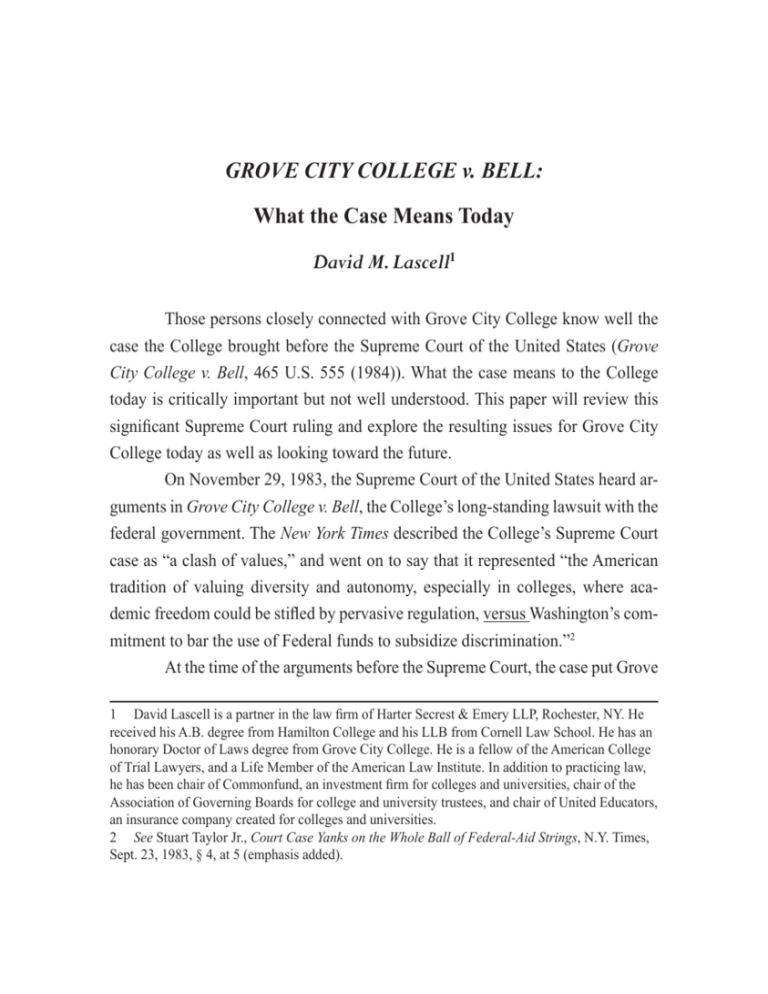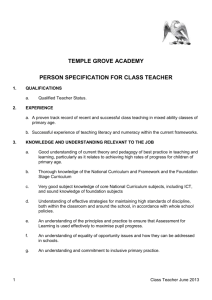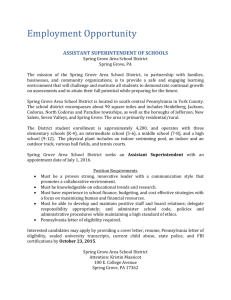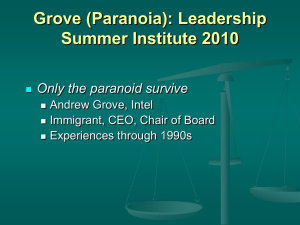GROVE CITY COLLEGE v. BELL: What the Case Means Today
advertisement

GROVE CITY COLLEGE v. BELL: What the Case Means Today David M. Lascell1 Those persons closely connected with Grove City College know well the case the College brought before the Supreme Court of the United States (Grove City College v. Bell, 465 U.S. 555 (1984)). What the case means to the College today is critically important but not well understood. This paper will review this significant Supreme Court ruling and explore the resulting issues for Grove City College today as well as looking toward the future. On November 29, 1983, the Supreme Court of the United States heard arguments in Grove City College v. Bell, the College’s long-standing lawsuit with the federal government. The New York Times described the College’s Supreme Court case as “a clash of values,” and went on to say that it represented “the American tradition of valuing diversity and autonomy, especially in colleges, where academic freedom could be stifled by pervasive regulation, versus Washington’s commitment to bar the use of Federal funds to subsidize discrimination.”2 At the time of the arguments before the Supreme Court, the case put Grove 1 David Lascell is a partner in the law firm of Harter Secrest & Emery LLP, Rochester, NY. He received his A.B. degree from Hamilton College and his LLB from Cornell Law School. He has an honorary Doctor of Laws degree from Grove City College. He is a fellow of the American College of Trial Lawyers, and a Life Member of the American Law Institute. In addition to practicing law, he has been chair of Commonfund, an investment firm for colleges and universities, chair of the Association of Governing Boards for college and university trustees, and chair of United Educators, an insurance company created for colleges and universities. 2 See Stuart Taylor Jr., Court Case Yanks on the Whole Ball of Federal-Aid Strings, N.Y. Times, Sept. 23, 1983, § 4, at 5 (emphasis added). 2 the grove city college journal of law and public policy [vol. 1:1 City College on the front pages of national newspapers, as the lead story on major networks’ evening news programs, and as the subject of countless editorials, newspaper and magazine columns, and talk show discussions. The case began in 1976, when the College received an “Assurance of Compliance” with Title IX of the Education Amendments of 1972 from the federal government’s Department of Health, Education and Welfare (the relevant part of which is now the Department of Education). Title IX forbade schools that received federal financial assistance from discriminating based on gender, which Grove City College did not do. It had been coeducational since its founding in 1869. Half its students and many of its faculty were women. The College believed in and practiced a policy of non-discrimination. The Assurance of Compliance, at that time, required more than just a pledge of non-discrimination, however. More significantly, it required an agreement by the College to abide by all federal regulations, of whatever kind, as they existed in 1976 and forevermore. The College decided that the federal government asked too much. How would this private college remain efficient and cost effective in the face of significant federal regulation? After all, chair of the board at that time said, there is “no such thing as a little bureaucratic control.” The College had never been a direct recipient of federal financial assistance – federal dollars supporting the institution. Federal financial assistance was the lynchpin of federal regulation and without it, no connection between the College and the federal government existed, and no regulation under the terms of Title IX could occur. The College itself received no direct federal funding in 1976, or ever. A few of its students, however, participated in the Stafford Federal Loan Program, today called Pell Grants. The College was not itself directly involved in those programs. It merely confirmed the participant’s status as a student, the same as it did for several private grant or loan programs. It did not administer the programs 2010] Grove City vs. Bell 3 in any way, and the government funds went directly to the students. The College declined to sign the “Assurance,” and the contest began. From the College’s position, the case was about an important principle: refusal to agree to federal entanglement and regulation and not about any intent on the part of the College to allow discrimination. However, in a 6-3 decision, the College lost its appeal in the United States Supreme Court. The College took comfort in the language of Justice Powell’s concurring opinion: “[T]he [government] has prevailed, having taken this small independent College, which it acknowledges has engaged in no discrimination whatever, through six years of litigation with the full weight of the Federal Government opposing it. . . .3 ‘It should also be noted that there was not the slightest hint of any failure to comply with Title IX, save the refusal to submit an executed assurance of compliance with Title IX. This refusal was obviously a matter of conscience and belief.’”4 The Supreme Court determined that by having enrolled students who received Pell Grants, the College was an indirect recipient of federal financial assistance, and thus subject to federal regulation. Not all commentators thought the College had lost, however. According to the Court’s decision, only the financial aid/admissions office was subject to federal regulation, not the entire College. The program receiving federal assistance was subject to regulation, not the entire institution. To the College, however, that was enough. Tellingly, Congress passed a law four years later, the so-called “Civil Rights Restoration Act of 1988”, that expanded the Court’s decision and made the entire College subject to federal regulation if a single dollar of federal aid made its way into any part of the College’s 3 4 Grove City College v. Bell, 465 U.S. 555, 579 (1984). Id. at 578 (citing holding of Administrative Law Judge below). 4 the grove city college journal of law and public policy [vol. 1:1 coffers. How did the College react to the Court’s ruling? Using the roadmap provided by the Court’s opinion, the College withdrew immediately from the Pell Grant Program, and in 1996 from the Stafford Federal Loan Program, substituting its own grant and loan programs funded by monies the College raised privately. That remains the status today. The College takes no federal funding, either directly or indirectly, using its own privately funded loan and scholarship programs instead. Although the College’s course of action means fewer options for Grove City College students, the important principle of “no federal monies” remains intact. Turning to the second part of the analysis of the case, how do the rules established by the Court’s decision affect the current activities of the College? Does refusing to accept federal funding hurt the College’s competitive profile? What effect does the College’s stance suggest for its future? The College is committed to careful management that will not allow uncontrolled costs to determine its future, attempting to keep student costs “affordable.” In the upcoming academic year, Grove City College student costs will total approximately $20,000 for tuition, fees, and room and board, with a laptop computer and printer included. This moderate price tag is understandable given the college’s mission: to provide a quality, rigorous education at an affordable cost in a thoroughly Christian atmosphere. The College made a courageous and dramatic choice when it refused to execute the Assurance of Compliance in 1976. The College reaffirmed its decision when it withdrew from the Pell Grant Program and the Stafford Federal Student Loan Program after the Supreme Court decision in 1984 and the “Civil Rights Restoration Act” in 1988. Nevertheless, the College’s choices and its sensitive relationship with the federal government have created some difficulties. These include the unavailability of Pell Grants or Federal Stafford loans for Grove City College students, limitations on available federal internships for students, prohibiting them 2010] Grove City vs. Bell 5 from getting academic credit while working at the White House or a federal agency, and inhibited faculty from seeking federal research grants. Moreover, increases in government interference with the private sector raise additional areas of concern, e.g., use of governmentally funded research materials or tools. Independence has a very high cost that private funding has to offset if the College is to succeed in the very competitive higher education marketplace. Consider how deeply this issue intrudes into the life of the College, how it effects the College even in unexpected ways. Only last year, a student production of La Bête was judged to be among the best performed student plays in the country, alongside productions from the University of North Carolina at Chapel Hill, the University of Texas at Austin and the University of California, Berkeley. The cast was invited, all expenses paid, to perform the work at the Kennedy Center. The problem the College found was that the Department of Education was underwriting the trip paying all the costs. The College successfully found alternative funding, with cooperation from Kennedy Center administration, but this example shows just how far reaching the tentacles of the federal government can be. Another example: the College once had a very well respected ROTC program. Because of the College’s stance, the ROTC program was discontinued, much to the disappointment of the Department of the Army as well as to those students interested in the program who must now travel to Slippery Rock University to participate. Moreover, what of the veterans who wish to bring government benefits to the College, but cannot do so? The current academic world, especially at first-class teaching institutions, encourages student and faculty research. Much (even most) of that research is funded with federal dollars, either directly or indirectly. Grove City College students are among those most qualified to perform challenging internships and conduct outstanding student and faculty research, however, their opportunities are limited without additional funding. 6 the grove city college journal of law and public policy [vol. 1:1 You can sense where I am going with this analysis. Because of the College’s stand after the Supreme Court case, it is playing with one hand tied behind its back, a consequence it expected because of the position it took. The College is well known and highly regarded for its principled stand, but this College must work to replace, each year, what most institutions receive annually from the federal government in student aid, research grants, or federal contracts. The College cut itself off from the largest single source of funding in terms of assisting individual students to pay tuition, supporting students and faculty doing research, and even in drama competitions. Making up this deficit requires substantial effort, which is not easy in any economic environment, and is particularly difficult in this current one. Remember also, this College is almost alone in this independence effort in American higher education by choice and principle, so there is little empathy for the College’s position from funders or federal agencies. This issue is not one for which the College can expect a broad base of support. To thrive over the coming decades, the College and its supporters will need to find alternative sources of funds. For the College, that will require significant effort by its leaders, and substantial help from outside the College community. Like so many very worthwhile principles, freedom and independence come with a high cost. Editor’s Note: The College’s independence may once again be put to the test – this time more severely – by certain movements afoot in Washington. As these threats become more imminent, we will address them in later issues of the Journal.






